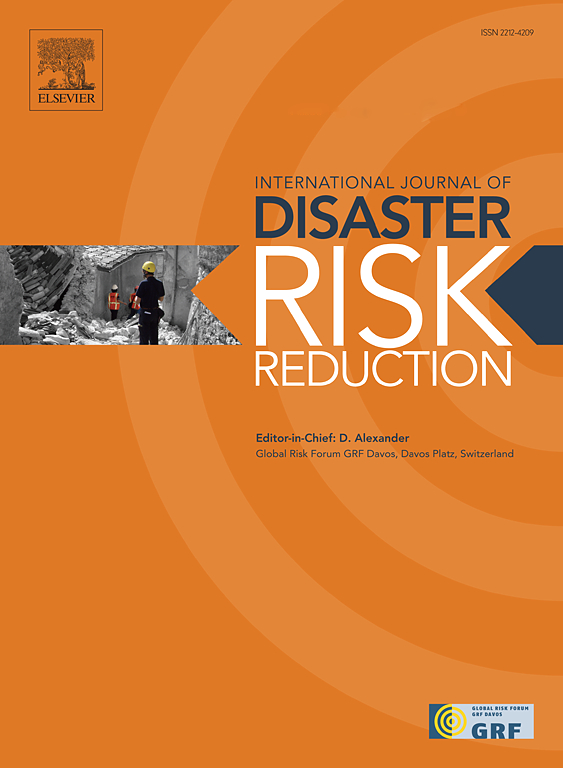A holistic approach for assesssing multidimensional adaptive capacity to floods: From conceptualization to empirical assessment
IF 4.2
1区 地球科学
Q1 GEOSCIENCES, MULTIDISCIPLINARY
International journal of disaster risk reduction
Pub Date : 2025-07-24
DOI:10.1016/j.ijdrr.2025.105729
引用次数: 0
Abstract
Adaptive capacity is crucial for implementing adaptation and risk reduction strategies. This study conceptualizes adaptive capacity as a multidimensional construct, i.e., physical, social, economic, psychological, technological, and institutional dimensions. Indexes are computed using the composite index method, and their values are calculated based on descriptive statistics to facilitate data normalization. Significant differences were evaluated using one-way analysis of variance (ANOVA) tests, and the impacts were assessed through multiple regression analysis. Three flood-prone urban communities of Islamabad, Pakistan, namely Chak Shahzad, Sector E−11/D-12, and River/Soan Garden, were selected. Data was collected from a random sample of 600 households, with 200 households each from the selected communities. A structured questionnaire containing 48 indicators across the dimensions was used. Communities were found to have a moderate adaptive capacity (mean = 0.52), with higher capacity in the physical (mean = 0.64) and technological (mean = 0.58) dimensions, while lower capacity levels were observed in the economic (mean = 0.41) and institutional (mean = 0.49) dimensions. The presence of elderly household members and the extent of flood damage was positively associated with adaptive capacity, whereas past flood experiences had a negative impact. Non-conformity to land-use and zoning laws, the absence of social protection programs and insurance, and ineffective warning were the main factors reducing adaptive capacity. This highlights the need to formulate effective adaptation strategies and policies to improve the adaptive capacity of the communities. The approach can also be applied to other settings and hazards to understand the adaptive capacity at different spatial scales.
评估洪水多维适应能力的整体方法:从概念化到实证评估
适应能力对于实施适应和减少风险战略至关重要。本研究将适应能力定义为一个多维结构,即生理、社会、经济、心理、技术和制度维度。使用复合指数法计算索引,并根据描述性统计计算其值,以便于数据归一化。采用单因素方差分析(ANOVA)检验评估显著性差异,采用多元回归分析评估影响。巴基斯坦伊斯兰堡的三个洪水易发城市社区,即Chak Shahzad, E - 11/D-12区和River/Soan Garden被选中。数据是从随机抽样的600户家庭中收集的,每个家庭来自选定的社区200户。使用了包含48个维度指标的结构化问卷。研究发现,社区具有中等的适应能力(平均= 0.52),其中物理(平均= 0.64)和技术(平均= 0.58)维度的适应能力较高,而经济(平均= 0.41)和制度(平均= 0.49)维度的适应能力水平较低。老年人家庭成员的存在和洪水破坏程度与适应能力呈正相关,而过去的洪水经历对适应能力有负面影响。不遵守土地利用和区划法、缺乏社会保障和保险、预警无效是降低适应能力的主要因素。这凸显了制定有效的适应战略和政策以提高社区适应能力的必要性。该方法还可以应用于其他环境和灾害,以了解不同空间尺度下的适应能力。
本文章由计算机程序翻译,如有差异,请以英文原文为准。
求助全文
约1分钟内获得全文
求助全文
来源期刊

International journal of disaster risk reduction
GEOSCIENCES, MULTIDISCIPLINARYMETEOROLOGY-METEOROLOGY & ATMOSPHERIC SCIENCES
CiteScore
8.70
自引率
18.00%
发文量
688
审稿时长
79 days
期刊介绍:
The International Journal of Disaster Risk Reduction (IJDRR) is the journal for researchers, policymakers and practitioners across diverse disciplines: earth sciences and their implications; environmental sciences; engineering; urban studies; geography; and the social sciences. IJDRR publishes fundamental and applied research, critical reviews, policy papers and case studies with a particular focus on multi-disciplinary research that aims to reduce the impact of natural, technological, social and intentional disasters. IJDRR stimulates exchange of ideas and knowledge transfer on disaster research, mitigation, adaptation, prevention and risk reduction at all geographical scales: local, national and international.
Key topics:-
-multifaceted disaster and cascading disasters
-the development of disaster risk reduction strategies and techniques
-discussion and development of effective warning and educational systems for risk management at all levels
-disasters associated with climate change
-vulnerability analysis and vulnerability trends
-emerging risks
-resilience against disasters.
The journal particularly encourages papers that approach risk from a multi-disciplinary perspective.
 求助内容:
求助内容: 应助结果提醒方式:
应助结果提醒方式:


